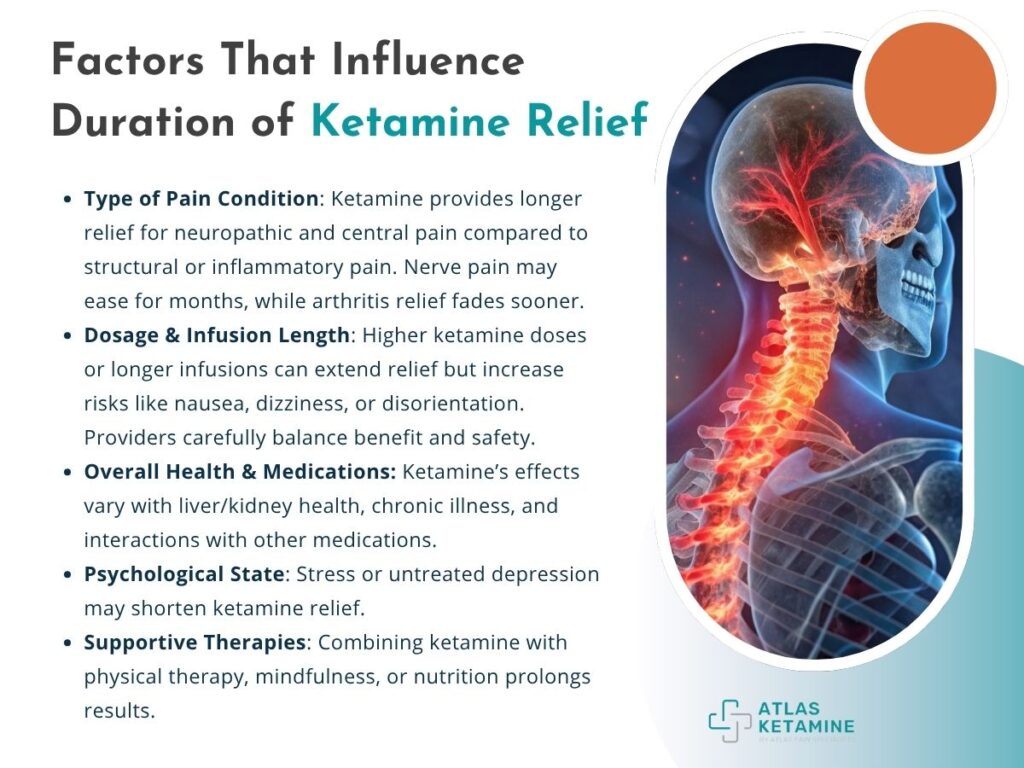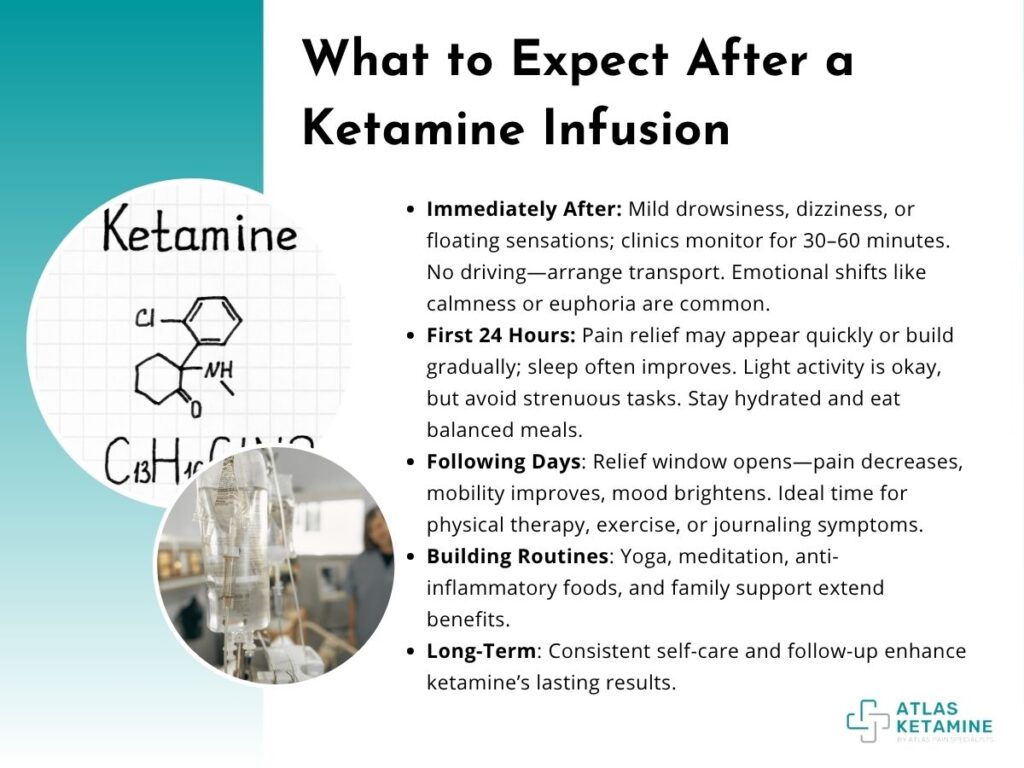Living with chronic pain can feel like carrying an invisible weight each day. Traditional treatments such as opioids, nerve blocks, or anti-inflammatory drugs often provide only partial relief or come with difficult side effects.
This is why ketamine infusion therapy has gained attention in recent years. Many people considering this option often ask the same question: how long does ketamine infusion last for pain?
The short answer is that the pain-relieving effects can range anywhere from a few days to several months, depending on the condition being treated, individual response, and follow-up care. To understand this better, let’s break it down into key aspects.
Ketamine and Its Role in Pain Relief
Ketamine was first developed in the 1960s as an anesthetic used during surgery. Over time, doctors noticed that patients also experienced mood improvements and decreased pain even after the drug had worn off.
Today, low-dose ketamine is being used in controlled medical settings to help people with chronic pain syndromes such as complex regional pain syndrome (CRPS), fibromyalgia, and neuropathic pain.The reason ketamine works differently than traditional painkillers is that it targets NMDA receptors in the brain and spinal cord, helping to “reset” pain pathways rather than simply dulling pain signals.
This makes it especially effective for pain that has not responded well to other medications.To put this into perspective, imagine pain as a road filled with potholes and traffic jams. Ordinary painkillers work like traffic lights, briefly stopping signals to ease congestion.
Ketamine, on the other hand, repairs parts of the road itself. It reshapes how the nervous system interprets pain, which is why its results often last longer than standard medications.For conditions like fibromyalgia, where pain originates from misfiring nerve signals rather than physical injury, this pathway reset can bring relief that patients haven’t felt in years.
How Long Does One Infusion Typically Last?
When someone receives their very first ketamine infusion, the pain relief can last anywhere from a few hours to several days. In clinical practice, most patients notice improvement within the first 24 hours. However, how long the benefits last depends on factors such as dosage, infusion length, and the type of pain condition being treated.
On average, the effects of a single infusion last between three days and two weeks for pain relief. Some patients with neuropathic conditions may report relief extending to a month or more, while others find the benefit shorter.

This variability is one reason most treatment plans involve a series of infusions rather than just one. For example, a patient with CRPS who has lived with burning nerve pain for years may find that after one infusion, their pain drops from a “9” to a “5” on the pain scale for several days.
This window of relief, even if brief, is often the first step toward regaining function. By the second or third infusion, they may notice pain-free intervals lasting longer. It is also worth noting that pain relief and mood improvement can last for different lengths of time.
The Role of Multiple Infusion Protocols
Because single infusions provide short-term relief, doctors often recommend a structured protocol of several treatments spaced closely together. This “loading phase” helps the nervous system adapt to the changes ketamine introduces.
When patients undergo a full series of infusions,often six to eight sessions over two to three weeks, the pain relief can last for several weeks to several months. In fact, studies have shown that building this cumulative effect is key for sustained benefit.
Maintenance Infusions
After the initial loading phase, many patients return for “booster” or maintenance infusions. These are scheduled every few weeks or months, depending on how quickly pain symptoms return.
Some people only need maintenance every three to six months, while others require them monthly.
Individual Variability
Responses to ketamine vary widely. For example, a patient with CRPS may experience significant relief lasting several months after a protocol, while someone with widespread fibromyalgia may notice only modest improvements that require more frequent boosters.
Doctors often adjust timing and dosage based on the patient’s condition and response, making this a highly individualized treatment.
Factors That Influence Duration of Relief
Not everyone experiences the same timeline of pain relief. Several key factors influence how long ketamine’s effects last.The duration of relief depends on the type of pain condition, individual biology, overall health, and whether maintenance care is followed.
1. Type of Pain Condition
Neuropathic and central pain syndromes tend to respond better than structural or inflammatory pain. Nerve damage pain may be eased for months, while arthritis pain relief may fade sooner.
This difference helps explain why ketamine is considered a specialty treatment rather than a universal one.
2. Dosage and Infusion Length
Higher doses and longer infusion times can sometimes extend the relief, but these must be balanced against side effects such as nausea, dizziness, or temporary disorientation. Medical providers carefully calculate dosages to maximize benefit without compromising safety.
3. Overall Health and Medications
Patients with other chronic illnesses or those taking multiple medications may metabolize ketamine differently. Liver function, kidney health, and interactions with antidepressants or anticonvulsants can all influence how long ketamine’s effects persist.
4. Psychological State and Stress
Since ketamine also influences mood, those with high stress or untreated depression may find that emotional health impacts how long pain relief lasts. Addressing both mind and body is often critical to longer results.
5. Supportive Therapies
Patients who combine ketamine with physical therapy, mindfulness practices, or anti-inflammatory nutrition plans often report longer-lasting relief. This shows that ketamine works best when supported by a holistic care plan.
Comparison of Infusion Duration by Condition
To illustrate how variable ketamine relief can be, here is a simple comparison table showing average timelines based on condition:
| Condition | Typical Duration of Relief from Initial Protocol | Maintenance Frequency |
| Complex Regional Pain Syndrome | 1–3 months | Every 2–3 months |
| Fibromyalgia | 3–8 weeks | Every 1–2 months |
| Neuropathic Pain (general) | 1–2 months | Every 2–3 months |
| Arthritis-related Pain | Days to a few weeks | Monthly or as needed |
| Post-surgical or Acute Pain | 1–4 weeks | Case-by-case |
This comparison highlights that while ketamine can bring months of relief for nerve-related pain, conditions rooted in joint or structural damage often require more frequent care.
Living with Ketamine as a Long-Term Option
For many patients, ketamine infusion is not a one-time cure but part of a larger pain management strategy. Integrating it with lifestyle changes, physical therapy, and mental health support often makes the relief last longer.
Ketamine infusion is most effective when combined with a holistic pain management plan that includes follow-up care, therapy, and healthy habits.
Long-Term Considerations
Patients often describe ketamine as giving them a window of opportunity. During this window, they can begin gentle exercise, re-engage with activities they once avoided, and strengthen coping skills.
While ketamine is generally safe under medical supervision, long-term use requires regular check-ins. Doctors monitor not just pain levels but also kidney and liver function, psychological well-being, and any side effects.
When carefully managed, ketamine can reduce dependence on opioids and improve quality of life.
Lifestyle Support
A ketamine boost, many remain too limited by pain to take these steps. Doctors frequently encourage journaling pain levels and daily activities to track progress.
A record of how long relief lasts, what activities improve, and when pain returns helps providers design the best maintenance schedule. Simple lifestyle shifts often extend relief.
Stress management, adequate sleep, low-impact exercise, and balanced nutrition can all support nervous system health. These strategies help maximize the benefits of each infusion, making the intervals between treatments longer.
What to Expect After a Ketamine Infusion
One of the most common questions patients ask beyond how long the infusion will last is what happens once the session is over. Knowing what to expect helps reduce anxiety, encourages safe recovery, and allows patients to make the most of the treatment window that follows.
The hours and days following an infusion are just as important as the infusion itself, because they shape how well the benefits are sustained. Patients who prepare ahead and follow post-infusion guidelines often find their relief lasts longer.

Immediately After Treatment
When the infusion ends, most people feel a little disoriented or drowsy. Some describe sensations like floating, mild dizziness, or changes in vision. These usually fade within an hour, but clinics typically monitor patients for at least 30 to 60 minutes before sending them home. Driving is not allowed afterward, so arranging transportation is necessary.
Many patients also report emotional shifts in the hours after treatment. They may feel lighter, calmer, or even slightly euphoric. Others may feel tired and simply want to rest. Both reactions are normal and usually subside by the next day.
The First 24 Hours
The day after an infusion is often when pain relief becomes noticeable. For some, the change is immediate they wake up feeling looser, with less stiffness or burning pain. For others, relief builds gradually over several hours. Sleep quality may improve that night, especially for those whose pain typically interrupts rest.
Patients are usually advised to take it easy for the first 24 hours. While light movement is encouraged, strenuous activity or heavy decision-making may be discouraged until the body fully settles. Drinking plenty of water and eating balanced meals can also support recovery.
The Following Days
As the initial side effects fade, patients often begin to experience their true “window” of relief. This is when pain levels are lowest, mobility increases, and mood is often brighter. Many patients use this time to re-engage with physical therapy or low-impact exercise routines. Doing so helps reinforce the nervous system reset that ketamine provides.
It is also during this stage that keeping a journal becomes useful. Tracking when pain decreases, how long the benefit lasts, and when symptoms begin returning gives both patients and providers a clearer picture of effectiveness. These notes are especially valuable when planning maintenance infusions.
Building Healthy Routines
The post-infusion period is also an opportunity to build habits that extend relief. Stretching, gentle yoga, meditation, and anti-inflammatory foods can all help sustain nervous system balance. Patients often report that combining ketamine with mindfulness or stress management practices results in longer-lasting benefits.
Family and social support can also make a difference. Some patients find that explaining their treatment to loved ones reduces misunderstandings and builds a stronger network for recovery. For example, a spouse may encourage light walks during the pain-free window, reinforcing physical improvement and emotional connection.
Long-Term Integration
Over time, patients often learn that how they use their post-infusion days directly affects how long the benefits last. A person who stays active, manages stress, and attends follow-up sessions usually experiences longer relief than someone who treats ketamine as a stand-alone intervention.
The takeaway is simple: ketamine infusion does not end when the IV is removed—the aftercare period is where its true potential is realized. Patients who embrace this phase as part of their therapy journey tend to get the best results, both in duration of relief and quality of life.
How Long Does Ketamine Infusion Last for Pain? Final Takeaway
So, how long does ketamine infusion last for pain? The answer lies in a range rather than a fixed number. Relief from a single infusion may last just a few days, while a complete series of treatments can extend that relief for several months.
With proper maintenance and integration into a broader treatment plan, some patients can sustain comfort and improved function for the long term. The real measure of ketamine infusion is not just how long it lasts, but how much it improves quality of life when combined with other supportive strategies.
